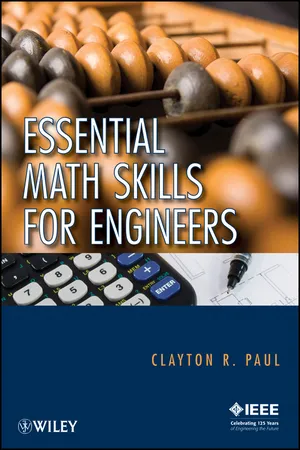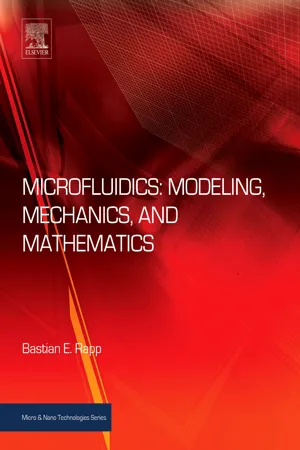Technology & Engineering
System of Differential Equations
A system of differential equations is a set of equations that describe how one or more variables change over time. These equations are used to model dynamic systems in various fields such as physics, engineering, and biology. Solving a system of differential equations involves finding the functions that satisfy all the equations simultaneously, providing insights into the behavior of the system.
Written by Perlego with AI-assistance
Related key terms
6 Key excerpts on "System of Differential Equations"
- eBook - ePub
Advanced Problem Solving with Maple
A First Course
- William P. Fox, William C. Bauldry(Authors)
- 2019(Publication Date)
- Chapman and Hall/CRC(Publisher)
3Introduction, Basic Concepts, and Techniques in Problem Solving with Systems of Ordinary Differential Equations
Objectives(1) Define and build a System of Differential Equations for a real problem. (2) Find a solution. (3) Graph a solution. (4) Understand equilibrium values and stability. (5) Solve both linear and nonlinear systems of differential equations. (6) Solve systems of differential equations. (7) Use numerical approaches to obtain good approximate solutions to differential equations and systems of differential equations.3.1 Systems of Differential Equations
Interactive situations occur in the study of economics, ecology, electrical engineering, mechanical systems, control systems, systems engineering, and so forth. For example, the dynamics of population growth of various species is an important ecological application of applied mathematics.Your uncle recently retired and bought farm land in South Carolina. His desire is to have a fishing pond; his favorite fish to catch are rainbow trout and brown trout. He finds he has a fair size fresh water pond on his land, but it contains no fish. He takes a water sample to the local fish and game authority. They analyze his water and conclude that the pond can sustain a fish population. He visits the local fish hatchers where they provide him the growth rates of rainbow trout and brown trout in isolation, call these values r and b, respectively. The experts tell him that rainbow trout and brown trout have the same food sources and will compete for the oxygen in the water as well as for food for survival. Data from the American Fisheries Society estimates the interaction rates between rainbow trout and brown trout for survival; call these rates m and n respectively. We desire to build a mathematical model to help your uncle determine if the pond can sustain both species of fish. This leads to a competitive hunter - eBook - ePub
- Clayton R. Paul(Author)
- 2011(Publication Date)
- Wiley-IEEE Press(Publisher)
4Solution of Linear, Constant-Coefficient, Ordinary Differential EquationsEngineering systems have inputs that are usually functions of time, denoted as t. Static engineering systems are generally governed by algebraic equations. Dynamic engineering systems are generally governed by differential equations. These differential equations contain derivatives with respect to time t and are somewhat more difficult to solve than are algebraic equations. In this chapter we examine the most common type of differential equation that is frequently found in engineering systems: the linear, constant-coefficient, ordinary differential equation.4.1 HOW TO IDENTIFY LINEAR, CONSTANT-COEFFICIENT, ORDINARY DIFFERENTIAL EQUATIONSWhat do they look like? In these equations there is only one independent variable, which we denote as t (perhaps symbolizing time). The function to be solved for is denoted as x(t). Since the unknown is a function of t, any derivatives will be with respect tot: dx(t)/dt, d2 x(t)/dt2 ,and so on. These are said to be ordinary derivatives, as opposed to partial derivatives. A derivativedn x(t)/dtnis said to be of order n.The general form of a first-order ordinary differential equation is(4.1a)The general form of a second-order ordinary differential equation is(4.1b)The coefficients a and b are constants and are known (given). The right-hand-side function of t,f(t), is also known (given). The right-hand side,f(t), is called the forcing function since it represents the source that is driving the engineering system. The task will be to solve for a function x(t) which when substituted into the equation, satisfies it. It is always a good idea to make the leading coefficient unity I All of our results apply, of course, in identical fashion to differential equations where the independent and dependent variables might have different symbols and meanings, such as y(x). - Bastian E. Rapp(Author)
- 2016(Publication Date)
- Elsevier(Publisher)
Chapter 3Engineering Mathematics
3.1 Differential Equations
3.1.1 Introduction
In this section, we will look at some of the most important (partial) differential equations that we come across in practical mathematics, physics, and (obviously) fluid mechanics. It is always astonishing to see how different physical phenomena can be reduced to the same type of differential equation. Obviously, once a solution to a prototypical differential equation has been found, this may open up entirely new roads to solving a large set of physical problems. These problems may, from the physical point of view, have nothing in common; still, they can be reduced to the same type of underlying equation.Before introducing the most important differential equations, we first want to make sure we understand what a differential equation actually is.3.1.2 Functions
Without going into too much detail, we will quickly introduce the term function and explain, what we mean when we refer to a function. For this, we first need to introduce a different term.3.1.2.1 Variable
In the mathematical sense, a variable is a placeholder for a value we do not know at the moment. Usually, it is desirable to write relations not using numbers. In many cases, these numbers change and we do not want to redo the whole calculation. Therefore, we use placeholders, or variables.3.1.2.2 Equations
If we sum up several variables and establish correlations and relationships between them, we end up with something that is generally considered an equation . An equation puts several variables in a context that is physically meaningful. As an example, when calculating the weight of an object for which we know the density ρ and the volume V , we usually writem = ρ V(Eq. 3.1)Eq. 3.1 is an equation. It puts several variables in a physically meaningful context. Equations are valid for all values we plug into the variables. Obviously, we may need to adapt the units if they are not provided in International System of Units (SI) format, but other than that, this equation will always hold true. We can even reformulate this equation if we know the volume V and the mass m of an object, but not the density. In this case, Eq. 3.1- Devendra K. Chaturvedi(Author)
- 2017(Publication Date)
- CRC Press(Publisher)
7System Dynamics Techniques
7.1 Introduction
The concept of how to organize scientific research is undergoing a change. Initially research was a one-man activity. But, if resources are to match adequately team research is essential. Engineering has developed the recognition of the importance of System Engineering in order to achieve the optimum goal.System engineering is a formal awareness of the interaction between the parts of the system. The interconnection, the compatibility, the effect of one upon the other, the objectives of the whole, the relationship of the system to the users, and the economic feasibility must receive even more attention than the parts, if the final result is to be successful.In management as in engineering, we can expect that the interconnection and interaction between the components of the system will often be more important than the separate components themselves.7.2 System Dynamics of Managerial and Socioeconomic System
The nature of managerial and socioeconomic systems and their associated problems are examined in terms of their counterintuitive behavior, nonlinearity, and system dynamics. The need for obtaining the intermediate feedback about the efficacy policies before being implemented in the real life is highlighted, which can be fulfilled effectively by using system dynamics (SD) as a simulation methodology.The managerial and socioeconomic systems and their associate problems are complex in nature compared to engineering and physical systems. According to the hierarchy of system given by Boulding (1956) the social system lies next to transcendental system in complexity, that is, they have complexity of highest order among all worldly systems, and the level of knowledge about their functioning is comparatively limited. This complexity is a result of many factors including a large number of components and interactions, non-linearty in interaction, dynamics, growth, causality, endogenization of factors, and their counterintuitive nature.- eBook - ePub
Mathematical Modeling
Branching Beyond Calculus
- Crista Arangala, Nicolas S. Luke, Karen A. Yokley(Authors)
- 2018(Publication Date)
- Chapman and Hall/CRC(Publisher)
4Modeling with Differential Equations
Goals and Expectations
The following chapter is written toward students who have completed an introductory differential equations course. However, examples within the chapter have been written to include guidance for solving differential equations with computer software. Because of the potential use of technology to solve differential equations, the chapter could also be used by students who have not yet completed a differential equations course, but are somewhat familiar with computational software. Note that the Mathematica commands and MATLAB code presented are intended solely as examples, and not as instructional components for the respective software.Goals:- Section 4.1 (Introduction and Terminology): To introduce important terminology that is used when discussing differential equation models.
- Section 4.2 (First Order Differential Equations): To construct and solve models using first order differential equations.
- Section 4.3 (Systems of First Order Differential Equations): To construct and simulate models using a system of first order differential equations.
- Section 4.4 (Second Order Differential Equations): To construct and solve models utilizing second order differential equations.
4.1 Introduction and Terminology
In calculus, we learned that the derivativeis the ratio of the differential dx to the differential dt and that this derivative represents the change in the variable x with respect to the change in the variable t . For this derivative, the variable x is the dependent variable, and the variable tdxdt - Christopher Jekeli(Author)
- 2023(Publication Date)
- De Gruyter(Publisher)
2 Ordinary Differential Equations2.1 Introduction
Inertial navigation systems (INS) yield the position vector, x , and the velocity vector,x ˙, by integrating measured accelerations, essentially, according to equation (1.7). Such an equation is known as a differential equation: an equation that expresses a relationship between the derivative(s) of a function and the independent variable(s) and possibly the function itself.The general form of a differential equation, of order m , may be written as(2.1)Ft , y ,= 0 ,y ˙,y ¨, … ,y mwhere, first, we consider arbitrary, one-dimensional functionsy tthat are m times differentiable. Without loss in generality and apropos to INS the independent variable, t , is time. The derivative operator is denoted either, as before, by a dot over the function or by a parenthetical superscript. Since the function depends on only one independent variable in this case, the derivatives are total derivatives rather than partial derivatives, and (2.1) is known more accurately as an ordinary differential equation, distinct from partial differential equations that involve multivariate functions. Since our applications concern mostly functions in time, we restrict the discussion to the former.Given the differential equation (2.1) , it is desired to solve for the functiony t, which involves integrating the equation with respect to t
Index pages curate the most relevant extracts from our library of academic textbooks. They’ve been created using an in-house natural language model (NLM), each adding context and meaning to key research topics.





